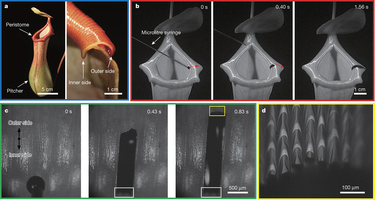On April 7, 2016, Nature publishes the research work titled “Continuous directional water transport on the peristome surface of Nepenthes alata”. The main authors of this paper are professors of Chen Huawei, Zhang Deyuan, from School of Mechanical Engineering and Automation of Beihang University, and academician of Jiang Lei from School of Chemistry and Environment of Beihang University. This work is the first paper published in Nature in fields of mechanical engineering of Chinese universities. The research studies unidirectional water transport phenomenon on the peristome surface of Nepenthes alata, and offers a new concept to construct the materials and surfaces with directional water transport capacity, which gives new insights into anti-adhesion in medical instruments.

Combining micro- and nano- structureswith surface materials endows the surface with unique capacity, i.e., functional surface techniques, gradually becomes a new important approach to solve the problems plagued with in fields of mechanical engineering, such as drag reduction, antifouling, and anti-bacteria. Nature has evolved into lots of surface structures with excellent functions after evolution of billions years, and understanding the mechanism of these unique function may bring new insights to innovate the technical revolution.
Slippery phenomenon has been found on the peristome surface of Nepenthes alata, knownas ‘aquaplaning’, resulting in theinsects’ easy-sliding into the pitcher when crawling on the wetted peristome. Previous studies have investigated the effects of the water film on the insect-prey and characterized the surface morphology, while nearly none of them involved the surface-material-function relationship. Chen et al first found the directional water transport phenomenon on the perstome surface of Nepenthes alata by observing the water movement on the surfaceafter being deposited. By in situ observation and surface structure analysis, they found that this unique water movement phenomenon results from its multiscale structure, which optimizes and enhances capillary rise, and prevents backflow in the reverse direction. By changing the surface wettability of artificial replica of the preistome surface, they also found the hydrophilicity is crucial important for the directional water transport, which doesn’t occur on the hydrophobic replica. This reported directional water transport speed is much higher than previous studies, and the mechanism underlying this phenomenon mightfind use in applications that call for directional fluid transport—forexample, in non-powered self-lubrication in mechanical engineering,MEMS, agricultural drip irrigation, anti-adhesion of medical instrument or in the non-powered deliveryof microdrugs.
This work obtains the financial support of National Natural Science Foundation of China (grant nos 51290292, 51175020, 51475029, and 21431009).
Web link:http://www.nature.com/nature/journal/v532/n7597/abs/nature17189.html
Copyright © 2024 International Society of Bionic Engineering All Rights Reserved
吉ICP备11002416号-1









